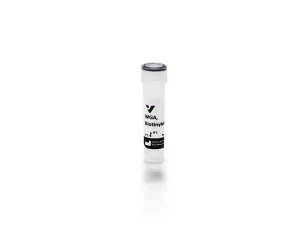GSL I-B4 isolectin contains only the B subunits. It is a useful marker for endothelial cells from nonprimates such as mouse, rat, rabbit, and goat as well as a marker for non-peptidergic unmyelinated primary afferent neurons. This “B”-rich lectin preferentially agglutinates blood group B cells and is specific for α-galactose residues.
DyLight™ 649 GSL I-B4 isolectin is produced by using special conjugation procedures to incorporate DyLight™ 649 into our affinity-purified lectin. This conjugate has an appropriate number of fluorochromes bound which provide the maximum fluorescence and optimum staining characteristics for this particular lectin. This reagent is supplied essentially free of unconjugated fluorochromes and inactive lectin.
| Unit Size | 0.5 mg |
|---|---|
| Applications | Immunofluorescence, Glycobiology |
| Recommended Usage | The recommended concentration range for use is 5-20 µg/ml. If a precipitate forms upon long-term storage, warm to 37 ºC. |
| Recommended Storage | 2-8 °C |
| Maximum Excitation | 655 nm |
| Maximum Emission | 670 nm |
| Solution | 10 mM HEPES, 0.15 M NaCl, pH 7.5, 0.08% sodium azide, 0.1 mM CaCl2. |
| Concentration | 1 mg active conjugate/ml |
| Conjugate | DyLight 649 |
| Color of Fluorescence | Far Red |
| Sugar Specificity | Galactose |
The Lycopersicon esculentum (tomato) lectin has been widely reported as an effective blood vessel marker for in vivo vascular perfusion studies in rodent species. Investigators have primarily utilized one of the fluorophore conjugated tomato lectin formats to trace blood vasculature in normal and diseased animals via tail vein or intracardiac injection. However, the biotinylated format has also been used. It allows for flexibility in subsequent visualization by way of either fluorescence or enzyme-based methods. Published references are best source for procedural details. Examples of references where biotinylated tomato lectins have been applied via in vivo perfusion are featured below: Robertson, R.T., et al. (2014) Histochem. Cell Biol. 143(2) Thurston, G., et al. (1998) Am. J Pathol. 153(4):1099-1112
GSL I is a family of glycoproteins with molecular weights of approximately 114 kDa. There are two types of subunits, termed A and B, with slightly different molecular weights. These subunits combine to form tetrameric structures, resulting in five isolectins. The A -rich lectin preferentially agglutinates blood group A erythrocytes and thus appears to be specific for α-N-acetylgalactosamine residues, while the B -rich lectin preferentially agglutinates blood group B cells and is specific for α-galactose residues. Our GSL I is a mixture of the five isolectins. GSL I has been reported to bind several glycoproteins including laminin.
Accompanying each fluorescent lectin is an analysis data sheet summarizing the results of our quality control tests and providing pertinent information on the product. All of these reagents are supplied as solutions preserved with sodium azide.
Inhibiting Sugar: 500 mM galactose or 100 mM raffinose
Applicable patents and legal notices are available at legal notices.




Stay in the Loop. Join Our Online Community
Products
Ordering
About Us
Application
Resources

©Vector Laboratories, Inc. 2025 All Rights Reserved.
To provide the best experiences, we use technologies like cookies to store and/or access device information. Consenting to these technologies will allow us to process data such as browsing behavior or unique IDs on this site. Not consenting or withdrawing consent, may adversely affect certain features and functions. Privacy Statement
How do I Request a Quote?
To request a quote for products: